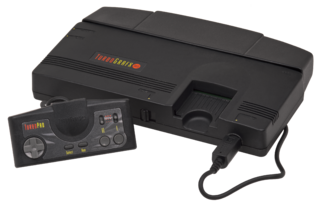Difference between revisions of "TurboGrafx-16"
From NEC Retro
Scarred Sun (talk | contribs) |
|||
| Line 12: | Line 12: | ||
}} | }} | ||
}} | }} | ||
| − | The '''TurboGrafx-16''' | + | The '''TurboGrafx-16''' is the North American variant of the [[PC Engine]], originally released in the territory in August 1989. |
PUT STUFF HERE | PUT STUFF HERE | ||
==Hardware== | ==Hardware== | ||
| + | From a technical point of view, the TurboGrafx-16 is largely identical to the PC Engine, however unlike many of its competitors (for example, the Sega Mega Drive or Super Nintendo), NEC radically overhauled the look of the console for its new target market. The TurboGrafx-16 was (perhaps artificially) physically lengthened, with a new black case and entirely different stylings. Its software and accessories use slightly different pin configurations, making them incompatible with their Japanese counterparts (likely as a form of regional lock-out, as opposed to technical benefits). | ||
| + | |||
| + | It was also marketed in an entirely different way, most notably its claim of being a 16-bit system in a market dominated by Nintendo and their 8-bit NES. This description is something of a misnomer, however, as the core CPU of the machine is 8-bit, offering only 16-bit advantages in terms of graphics. | ||
| + | |||
| + | In select countries of Europe, the TurboGrafx-16 is the basis for the non-numbered [[TurboGrafx]] system. Save for some minor modifications for PAL televisions, the two machines are thought to be identical. | ||
===Technical Specifications=== | ===Technical Specifications=== | ||
Revision as of 17:04, 26 September 2015

| ||||||||||
| TurboGrafx-16 | ||||||||||
|---|---|---|---|---|---|---|---|---|---|---|
| Manufacturer: NEC | ||||||||||
|
The TurboGrafx-16 is the North American variant of the PC Engine, originally released in the territory in August 1989.
PUT STUFF HERE
Hardware
From a technical point of view, the TurboGrafx-16 is largely identical to the PC Engine, however unlike many of its competitors (for example, the Sega Mega Drive or Super Nintendo), NEC radically overhauled the look of the console for its new target market. The TurboGrafx-16 was (perhaps artificially) physically lengthened, with a new black case and entirely different stylings. Its software and accessories use slightly different pin configurations, making them incompatible with their Japanese counterparts (likely as a form of regional lock-out, as opposed to technical benefits).
It was also marketed in an entirely different way, most notably its claim of being a 16-bit system in a market dominated by Nintendo and their 8-bit NES. This description is something of a misnomer, however, as the core CPU of the machine is 8-bit, offering only 16-bit advantages in terms of graphics.
In select countries of Europe, the TurboGrafx-16 is the basis for the non-numbered TurboGrafx system. Save for some minor modifications for PAL televisions, the two machines are thought to be identical.